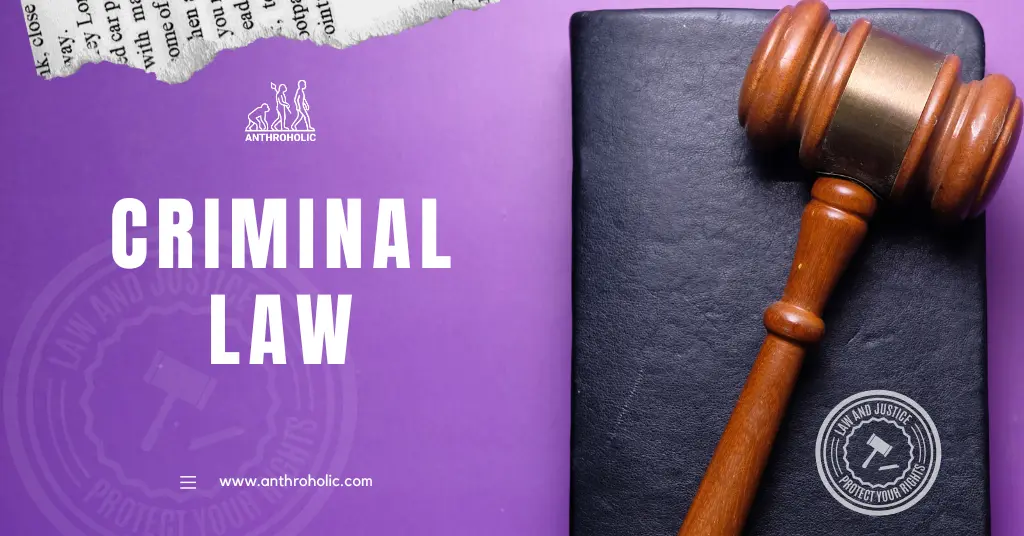AI Answer Evaluation Platform Live Now. Try Free Answer Evaluation Now
Criminal Law
Criminal law is an integral part of the justice system, responsible for regulating social conduct, deterring criminal activities, and maintaining public order. It sets out the parameters of lawful and unlawful behavior, stipulating punishments for transgressions [1].

Overview of Criminal Law
Criminal law encompasses several key components:
- Definition of Crimes: Criminal law categorizes various actions as crimes, detailing the elements needed for conviction [2].
- Establishment of Penalties: It establishes the appropriate penalties for each crime, from fines and probation to incarceration [2].
- Safeguarding Rights: It safeguards the rights of the accused, ensuring fair trials and humane treatment [3].
Types of Crimes
Crimes under criminal law are generally categorized into Personal Crimes, Property Crimes, Inchoate Crimes, Statutory Crimes, and Financial Crimes [4].
Table 1: Types of Crimes
| Type of Crime | Description | Example |
|---|---|---|
| Personal Crimes | Direct harm or threat against individuals | Assault, Robbery |
| Property Crimes | Interference with the property of another | Burglary, Theft |
| Inchoate Crimes | Started but not completed | Attempted robbery |
| Statutory Crimes | Violations of specific statutes | Selling alcohol to minors |
| Financial Crimes | Crimes against property, involving the unlawful conversion of ownership | Fraud, Embezzlement |
Key Principles of Criminal Law
Several key principles guide the operation and interpretation of criminal law:
- Presumption of Innocence: The accused is presumed innocent until proven guilty beyond a reasonable doubt [5].
- Double Jeopardy: An individual cannot be tried twice for the same offense [6].
- Right to a Fair Trial: Every accused person has the right to a fair trial, including the right to legal representation [7].
The Role of Criminal Law in Society
Criminal law plays an essential role in society by:
- Maintaining Order: It provides the framework to maintain public order and peace by discouraging antisocial behavior [8].
- Providing Redress: It offers a method of redress to victims of crimes [8].
- Preventing Vigilantism: It prevents private retaliation by providing legal methods for addressing grievances [9].
Criminal Law versus Civil Law
While both are integral parts of a country’s legal system, they differ significantly in purpose, process, and outcomes.
Table 2: Comparison of Criminal Law and Civil Law
| Aspect | Criminal Law | Civil Law |
|---|---|---|
| Purpose | Maintain social order, punish wrongdoing | Resolve disputes, compensate the wronged |
| Parties Involved | State vs. Defendant | Plaintiff vs. Defendant |
| Burden of Proof | Beyond reasonable doubt | Balance of probabilities |
| Outcome | Punishments (e.g., imprisonment, fines) | Remedies (e.g., damages, injunctions) |
Criminal Law Systems Globally
Criminal law systems vary around the world due to differences in legal traditions, historical experiences, and cultural norms. Here are brief overviews of the two predominant legal systems:
Common Law: Common law systems, originating from England and prevalent in countries like the United States, Canada, and Australia, rely heavily on case law. The judges’ interpretations in previous cases are binding precedents for future cases, ensuring consistent application of the law [10].
Civil Law: Civil law systems, found in most of Europe, Latin America, and parts of Asia and Africa, rely mainly on codified laws. Judges apply the law as written, without the binding effect of precedent [11].
The Process of a Criminal Case
A criminal case follows a series of steps from the initial accusation to the final sentencing [12]:
- Investigation: Law enforcement investigates to gather evidence relating to the crime.
- Charging: Prosecutors review the evidence and decide whether to file charges.
- Initial Hearing/Arraignment: Defendants learn about the charges against them and enter a plea.
- Discovery: Prosecution and defense exchange information.
- Plea Bargaining: The defendant may agree to plead guilty in exchange for a lesser sentence.
- Trial: If a plea agreement isn’t reached, the case goes to trial where evidence is presented, and a verdict is delivered.
- Sentencing: If found guilty, the judge determines the appropriate punishment.
Punishments in Criminal Law
Criminal law punishments aim to serve justice, deter potential criminals, and rehabilitate offenders [13]. They can include:
- Imprisonment
- Fines
- Community service
- Probation
- Restitution to victims
Modern Challenges and Reforms in Criminal Law
Contemporary criminal law faces numerous challenges, including [14]:
- Balancing societal security and individual rights, especially with advancements in surveillance technology.
- Addressing racial and social disparities in the criminal justice system.
- Ensuring the adequacy of legal representation for all accused individuals.
Reforms are ongoing, aiming to increase fairness, reduce systemic bias, and adapt to technological advancements.
Conclusion
In essence, criminal law is a comprehensive mechanism designed to maintain social order, protect individuals’ rights, and deter criminal behavior. Its applications are wide-ranging, ensuring public safety and helping create a society where the rule of law prevails.
References
[1] Herring, J. (2018). Criminal Law: Text, Cases, and Materials. Oxford University Press.
[2] Dressler, J. (2015). Understanding Criminal Law. LexisNexis.
[3] UNODC. (2011). Handbook on the rights and duties of law enforcement officials. United Nations.
[4] Simester, A. P., & Sullivan, G. R. (2019). Criminal Law: Theory and Doctrine. Hart Publishing.
[5] Ashworth, A., & Horder, J. (2013). Principles of Criminal Law. Oxford University Press. https://aghalibrary.com/storage/books/1609402608_AghaLibrary.pdf
[6] Grano, J. D. (1993). Double Jeopardy: The Misunderstood Constitutional Principle. New York Law School Law Review.
[7] Hodgson, J. (2002). The Human Right to Counsel in Criminal Cases: An International Perspective. Law & Society Review.
[8] Murphy, J. G., & Hampton, J. (1990). Forgiveness and Mercy. Cambridge University Press.
[9] Fuller, L. L. (1971). The Morality of Law: Revised Edition. Yale University Press.
[10] Baker, J. H. (2002). An Introduction to English Legal History. Butterworths.
[11] Merryman, J. H., & Pérez-Perdomo, R. (2007). The Civil Law Tradition: An Introduction to the Legal Systems of Europe and Latin America. Stanford University Press.
[12] LaFave, W. R., Israel, J. H., & King, N. J. (2004). Criminal Procedure. West Academic.
[13] von Hirsch, A., & Ashworth, A. (1998). Principled Sentencing: Readings on Theory and Policy. Hart Publishing.
[14] Tonry, M. (2017). Sentencing Fragments: Penal Reform in America, 1975-2025. Oxford University Press.

![The Cambrian Period, roughly 541 to 485.4 million years ago, marks a significant era in the history of life on Earth[1]. During this time, a remarkable explosion of diversity occurred, with the first appearance of many multicellular organisms and early forms of many major groups of animals alive today.](https://anthroholic.com/wp-content/uploads/2023/08/Cambrian-Era-in-Geological-Time-Scale-in-Archaeology-300x157.webp)


